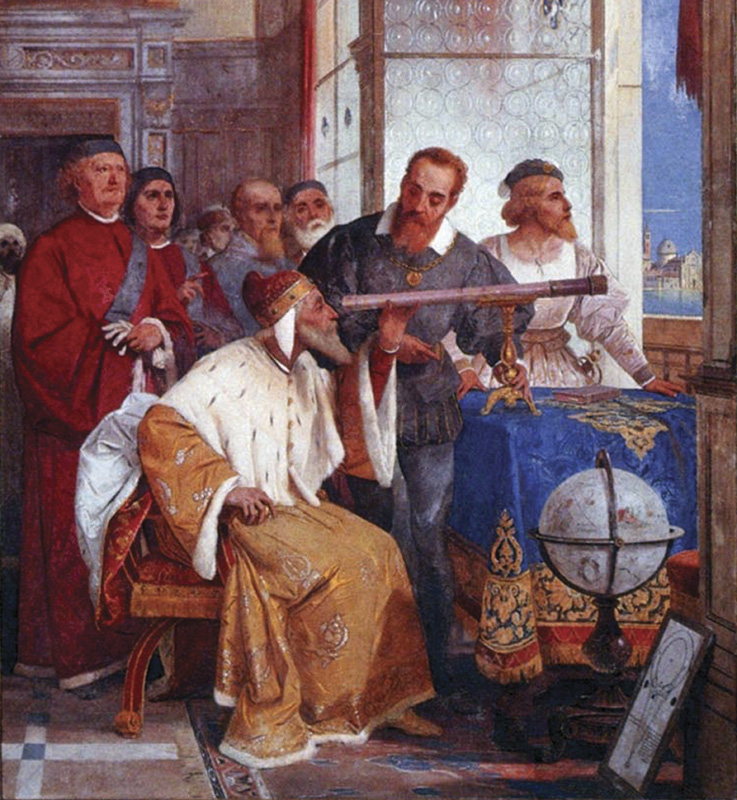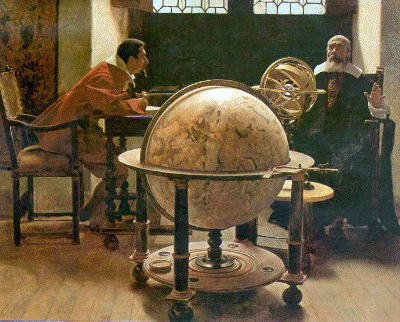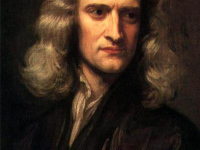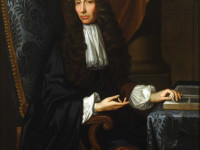
Galileo Galilei showing the Doge of Venice how to use the telescope,
Fresco at Villa Andrea Ponti, Varese, 1858
On August 25, 1609, Galileo Galilei publicly demonstrated his newly built telescope to Venetian lawmakers. Besides its astronomical value Galileo‘s telescope was also a profitable sideline for him selling telescopes to merchants who found them useful both at sea and as items of trade. Galileo published his initial telescopic astronomical observations in March 1610 in a brief treatise entitled Sidereus Nuncius (Starry Messenger).
Galileo Galilei Education and Early Career
Galileo Galilei came from an impoverished Florentine patrician family. Galilei was educated as a novice in the monastery of the Vallombrosans and was inclined to enter the Benedictine order, but was brought home by his father and sent to Pisa in 1580 to study medicine, where Galileo enrolled in 1581. But soon after, the story goes that he was fascinated by observing a swinging chandelier, when he noticed that no matter how far it was swinging, it always took the same time swinging back and forth. He repeated this experiments with two pendulums at home which confirmed his observation. As a consequence, he broke off his studies and went to Florence to study mathematics with Ostilio Ricci, a scholar from Nicolo Tartaglia’s school. He made his living with private lessons, studied applied mathematics, mechanics and hydraulics and began to attract attention in the educated circles of the city with lectures and manuscripts. In 1586, Galileo made his first publication on the design of a hydrostatic balance he had invented (Theoremata circa centrum gravitatis solidorum), which first brought him to the attention of the scholarly world and in 1589, he was appointed to the chair of mathematics in Pisa. A year later already, he moved to the University of Padua, teaching geometry, mechanics, and astronomy until 1610.
Early Telescopes
During his time in Padua, Galileo made significant discoveries in both pure fundamental science as well as practical applied science. Among them was also his improvement of the telescope. However, the actual inventor of the telescope is unknown but word of it spread through Europe. Based only on those rather uncertain descriptions of the first practical telescope which Dutch spectacle maker Hans Lippershey [6] tried to patent in the Netherlands in 1608, Galileo, in the following year, was able to build a telescope with about 3x magnification. He later succeeded to improve the device significantly with up to about 30x magnification. With a Galilean telescope, the observer could see magnified, upright images on the earth — it was what is commonly known as a terrestrial telescope or a spyglass. For its design Galileo used a convergent (plano-convex) objective lens and a divergent (plano-concave) eyepiece lens. Because the design has no intermediary focus, the magnified picture results in a non inverted and upright image. Of course Galileo’s telescope cannot be compared with today’s standard in optical technology. Because of flaws in the shape of the lenses and the narrow field of view, the produced images were blurry and distorted. Nevertheless, despite these flaws, it was still good enough for Galileo also to explore the nocturnal sky – which made Galileo’s design for the time being the best telescope on the contemporary market.

Galileo e Viviani, 1892, Tito Lessi
Kepler’s Supernova and Jupiter
In 1604, Galileo was able to observe Kepler’s supernova.[7] Since this new star displayed no detectable diurnal parallax, Galileo concluded that it was a distant star, and therefore disproved the Aristotelian belief in the immutability of the heavens. His public advocacy of this view met with strong opposition. On 7 January 1610, Galileo observed with his telescope what he described at the time as “three fixed stars, totally invisible by their smallness“, all close to Jupiter, lying on a straight line with it. Subsequent observations showed that the positions of these “stars” relative to Jupiter were changing in a way that would have been inexplicable if they had really been fixed stars. Moreover, on 10 January, Galileo noted that one of them had disappeared, probably behind Jupiter. Thus, he concluded that the stars must be orbiting Jupiter, which have been later renamed the Galilean Moons in honour of their discoverer.[8] He published his initial telescopic astronomical observations in March 1610 in a brief treatise entitled Sidereus Nuncius (Starry Messenger).
The Jovian System
Galileo’s observations of Jupiter moons caused a revolution in astronomy: a planet with smaller planets orbiting it did not conform to the Aristotelian cosmology, which held that all heavenly bodies should circle the Earth. Thus, many astronomers simply refused to believe Galileo’s observation. In 1612, having determined the orbital periods of Jupiter’s satellites, Galileo proposed that with sufficiently accurate knowledge of their orbits, one could use their positions as a universal clock, and this would make possible the determination of longitude. Two years earlier in 1610, Galileo observed that Venus exhibited a full set of phases similar to that of the Moon, thus confirming the predictions of Nicolaus Copernicus made on the foundation of his heliocentric model.[9] Galileo also observed the planet Saturn, and at first mistook its rings for planets or moons. In later observations, Saturn’s rings were directly oriented at Earth, causing him to think that the two planets next to Saturn must have disappeared. When they reappeared several years later, Galileo was even more confused. Galileo was one of the first Europeans to observe sunspots, although Kepler had unwittingly observed one in 1607, but mistook it for a transit of Mercury.
How to sell a Telescope
But Galileo’s telescope was not only rather useful tool for astronomy. On 25 August 1609, he demonstrated one of his early telescopes, with a magnification of about 8x or 9x, to Venetian lawmakers, who also were excited about it. In this way, Galileo was able to sell his telescopes as a profitable sideline of his business as a scientist. The Venetian senate in return settled him for life in his lectureship at Padua and doubled his salary, but with the subsidiary clause that he would never receive a raise in salary again.[12] Merchants became his best customers, who found the telescopes rather useful both at sea as well as items of trade.
Carolin Crawford, Large Telescopes And Why We Need Them – Professor Carolin Crawford, [10]
References and Further Reading:
- [1] Galileo and 400 Years of Telescopic Astronomy
Grego, Mannion. Springer, 2010
- [2] Galileo Galilei at MacTutor History of Mathematics
- [3] Galileo Galilei at scienceworld
- [4] Galileo Galilei at Britannica Online
- [5] The Galileo Affair, SciHi Blog
- [6] Hans Lippershey and the Telescope, SciHi Blog
- [7] Much more powerful than expected – Kepler’s Supernova, SciHi Blog
- [8] Jupiter and the Galilean Moons, SciHi Blog
- [9] Nicolaus Copernicus and his heliocentric model, SciHi Blog
- [10] Carolin Crawford, Large Telescopes And Why We Need Them – Professor Carolin Crawford, 2012, Gresham College @ youtube
- [11] Galileo Galilei at Wikidata
- [12] A Telescope Chronology, at The Renaissance Mathematicus, Sep 4, 2009.
- [13] Whitehouse, D. (2009). Renaissance Genius: Galileo Galilei & His Legacy to Modern Science. Sterling Publishing
- [14] Edgerton, Samuel Y. (2009). The Mirror, the Window, and the Telescope: How Renaissance Linear Perspective Changed Our Vision of the Universe. Ithaca: Cornell University Press.
- [15] Timeline of the discovery of the moons of Jupiter, via Wikidata





